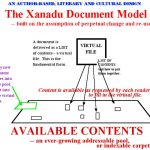This may seem a rather circuitous route to expounding on “the merit of “continuity” theory in the context of educational technology” (ETEC 540 66B > Pages > The problem with technological determinism), but there will be a tie-in that provides evidence that supplants discussions of the great divide in our evolution to a tri-modal expressive race. How we tackle educating our learners should then logically follow the continuity theoretical base.
The earliest examples of auditory to symbolic representation have been estimated to have been created in the late Pleistocene era, approximately 100,000 years ago. Using the cave acoustic signatures as a backdrop for inspiration, early Homo sapiens used their drawings as visual representations of sound. In the article Cross Modality Information Transfer: A Hypothesis about the Relationship among Prehistoric Cave Paintings, Symbolic Thinking, and the Emergence of Language, the authors mention how, using archeoacoustics, they have found that the location of cave paintings within the cave are related to the acoustic signature of a specific cave location. Where chambers create resonance and reverberation like that created by hoof beats, paintings of hoofed animals are found. Where there is a quiet acoustic signature, paintings of felines have been found (Miyagawa, Lesure, & Nóbrega. 2018).
In the Blombos Cave in South Africa, many pieces found have geometric engravings. Miyagawa, Lesure, & Nóbrega (2018) state that
“The idea is that the ochre engravings are an external, abstract representation of internal high-order cognitive processes. This is similar to spoken language, which is an external form of highly complex internal cognitive representations and computation.” (Miyagawa, Lesure, & Nóbrega. 2018. P.2).
It is forwarded in the article that these geometric carvings represent symbolic thinking. Here we see one of two themes from this writing that support the pertinence of the continuity theory in educational technology. Homo sapiens have been practicing visual representation using the tools and technology available to them in their particular time space place for many thousands of years. In the case of the cave paintings occurring in acoustic-specific locations, there is a connection made between the real world experience of hearing the hoof beats with coding and creating an externalized representation in an environment that reproduces the sound.
This ability to mentally transform an auditory modality into a graphical representation requires a cognitive shift from Homo sapiens’ previous lineage to one that is capable of symbolic thinking. For this to occur, there has to have been a cognitive alteration in the emerging Homo sapiens species. The sheer number and geographical spread of artefacts from this era suggest that this cognitive shift spread throughout this population rapidly and in blanket fashion (Miyagawa, Lesure, & Nóbrega. 2018. P.5). In the article, it was advanced that since various offshoots of the original human lineage all developed language, there must have been a pre-existing cognitive ability prior to the split. Miyagawa, Lesure, & Nóbrega (2018) point out that various ancient artworks and languages have a number of similarities. They occur across all human groups, display communication attributes, and externalize an interpretation of various lived experiences emanating from an internal cognitive state. The authors further point out that the FOXP2 gene is equated to linguistic ability in humans. This gene underwent a change in early modern man that
“affected a binding site for the transcription factor POU3F2 (Maricic et al., 2013; Huijbregts, 2017). The POU3F2 variant only occurs in modern humans, being absent from Neanderthals and Denisovans.” (Miyagawa, Lesure, & Nóbrega. 2018. P.6)
This second theme advanced postulates that the gene variant is seen as leading to the development of language. Due to the similarities with language, then, one can assume a similar, or indeed the same, genetic alteration may have likewise created the capacity for symbolic thinking that brought about the precursors to multi-modal expression and communication. As such, there is scientific evidence suggesting there was no jump or great divide from a purely linguistic externalization, but rather a natural progression or evolution as early man developed this symbolic cognition.
Finnegan (1988), as referenced by Chandler (1995), in Biases 0f the Ear and Eye, point to “a ‘continuum’ rather than a radical discontinuity between oral and literate modes, and an on-going dynamic interaction between various media (Finnegan 1988, pp. 139, 175).” (Chandler. 1995). Further, Chandler quotes a great divide defender who says “that orality and literacy are equivalent linguistic means for carrying out similar functions” and that “[t]he role of literacy is more social and institutional than it is psychological or linguistic.” (Chandler. 1995). While this unnamed great divide theorist is not presenting a ringing endorsement for continuity theory, what is implicit in the statement is literacy is still considered communication on a plane with linguistic ability. As such, it cannot be dismissed, discredited, or diminished as a medium by which we deliver an educational experience.
Miyagawa, Lesure, & Nóbrega (2018) present a compelling case for the continuity theory in the context of educational technology. The findings that symbolic thinking is a natural progression on the human evolutionary path, with both linguistic and literary representations inherent in this journey, indicates that educational technology, and indeed our development are on a continuum that, though may include periods of plateau, build on previous experiences. One simply has to look at the development of a person from birth through the formative years, from non-verbal, to verbal, to literary representations, for external manifestations of internal thought processes, to see a continuum rather than any type of divide in our development. Though we do progress through stages of a sort, we never truly leave a stage behind, rather we intermingle these as tools for external expression in our interactions in our society. Applying various forms of educational technology as a teacher assist the learner in the development of all three phases of external representation, non-verbal, verbal, and visual, as well as providing a conducive educational environment for those that best learn through a mix of these modalities. It also enables the learner to focus on the modality that best suits their particular educational needs. Progressing the learner through ever more sophisticated means of communication and expressive modalities follows the continuity theory in a progressively patterned learning process.
References:
Chandler, Daniel. “Biases of the Ear and Eye.” Media Representation, 18 Sept. 1995, visual-memory.co.uk/daniel/Documents/litoral/litoral2.html.
Miyagawa, S., Lesure, C., & Nóbrega, V. A. (2018). Cross-Modality Information Transfer: A Hypothesis about the Relationship among Prehistoric Cave Paintings, Symbolic Thinking, and the Emergence of Language. Frontiers in Psychology, 9. doi:10.3389/fpsyg.2018.00115







Ken
August 16, 2018 — 1:58 am
Bravo! What an informative read. Thank you for your work, you certainly have selected a challenging topic to write about. Your writing about archeoacoustics had me thinking about oral cultures. Specifically, I would hypothesize that the location of drawing was a gathering point where ancient two-legged’s would meet and recall the stories embedded within the paintings. The paintings represent events and shared memories that build cohesion. And just as scrolls, written for oratory, had cues and punctuation, I would infer that these drawings include long lost cues for shared audience participation (Haslam, 2005).
I appreciate how you have captured an essential theme of this course when you write “educational technology, and indeed our development are on a continuum that, though may include periods of plateau, build on previous experiences.” The invention of writing and the media used to preserve language (tablet, scroll, codex, print, digital) are proof that human progress and we can be sure that we are on the steepest wave of that continuum of remediation.
I wonder if the “modifications in social practice prompted the invention of writing” was agriculture? Writing becomes a necessary agent for remembering the harvests and for planning the next season. It is a glorious coincidence that writing emerges in the fertile crescent, the sub-continent of India, China and Meso-America to peoples who have developed agricultural practices (Bloom, 2001). Some of the indigenous people of North America were agriculturalists and very much oral cultures so some other social practice, or condition? Perhaps writing becomes a necessity once a population reaches a certain mark.
Thank you very much for your work and I wish you well on all future endeavors.
Respect,
Ken Lees
References
Bloom, J. M. (2001). Paper Before Print: The History and Impact of Paper in teh Islamic World. London: Yale University Press.
Haslam, M. W. (2005). The Physical Media: Tablet, Scroll, Codex. In J. ed. Foley, A Companion to Ancient Epic (pp. 142-163). Malden: Blackwell Publishing.